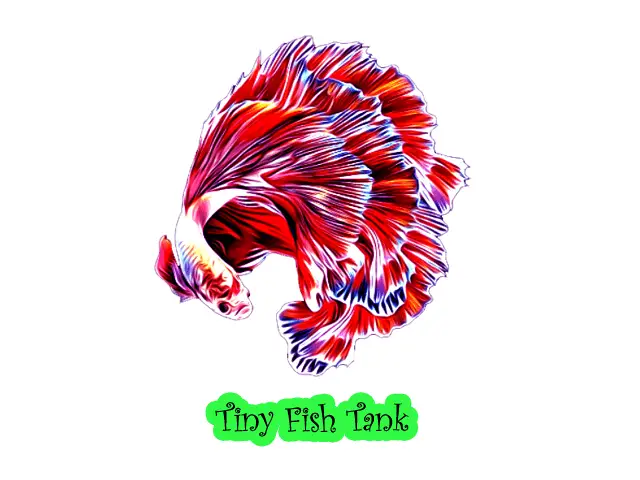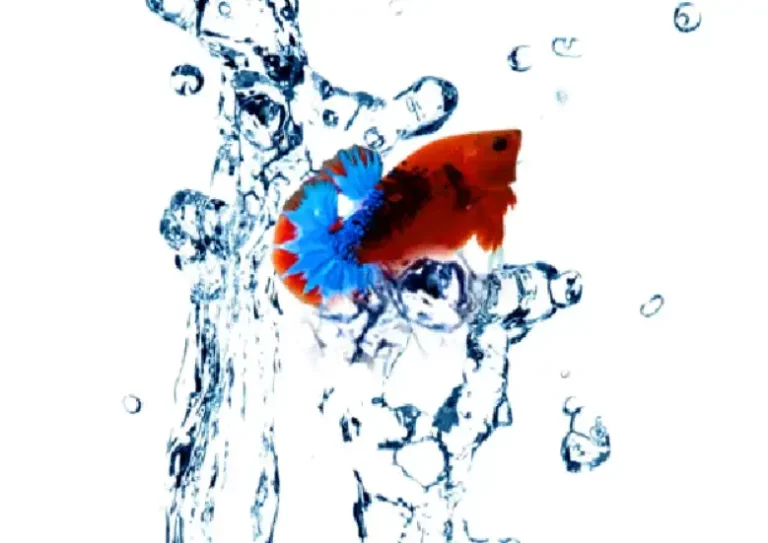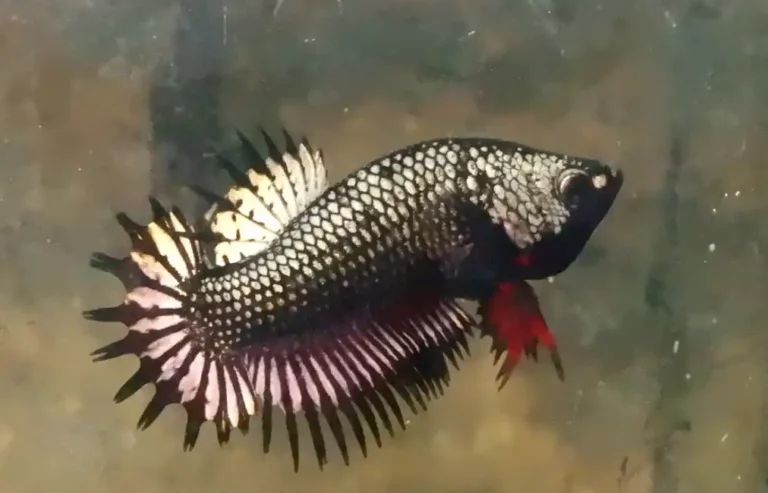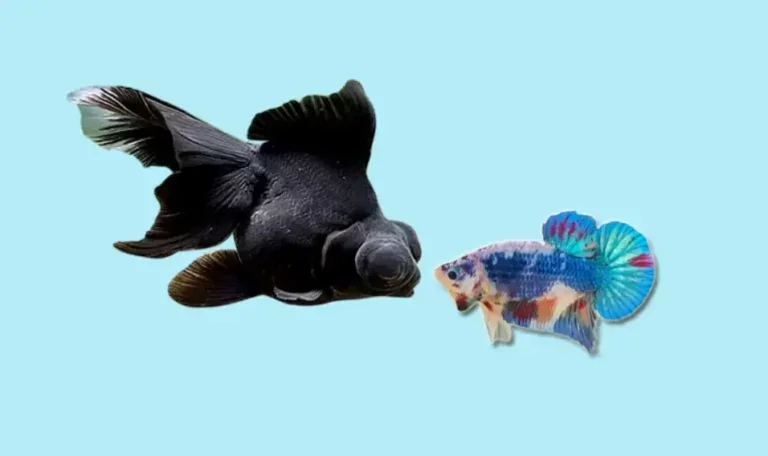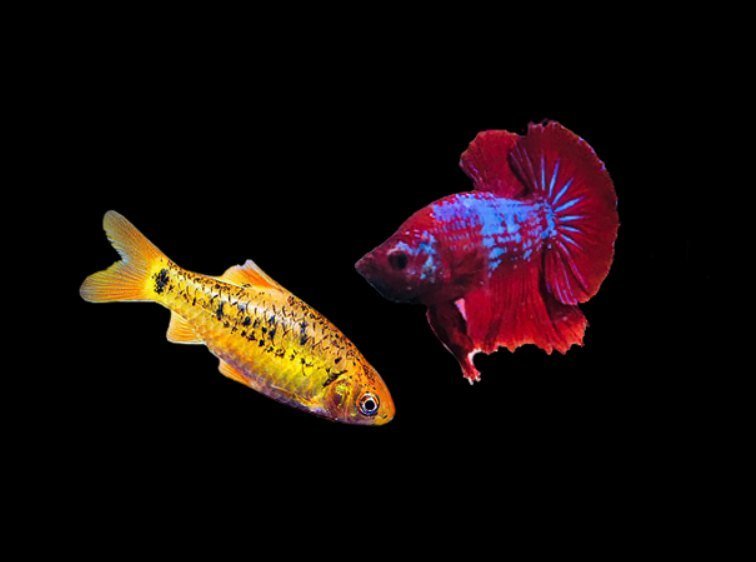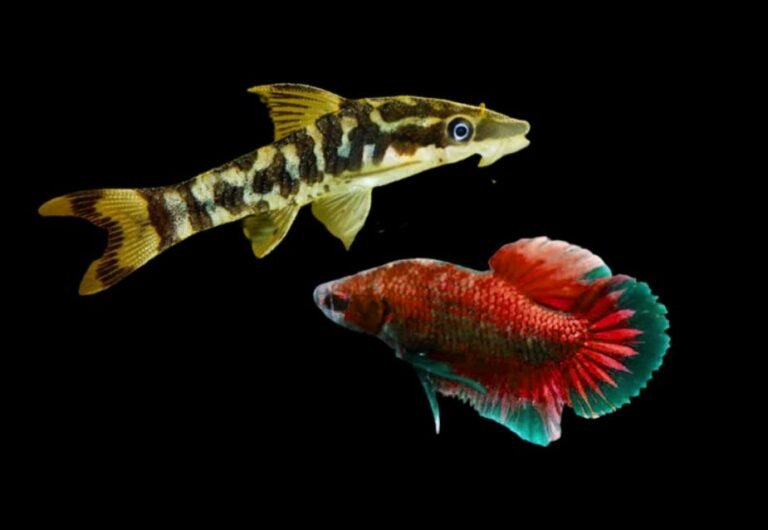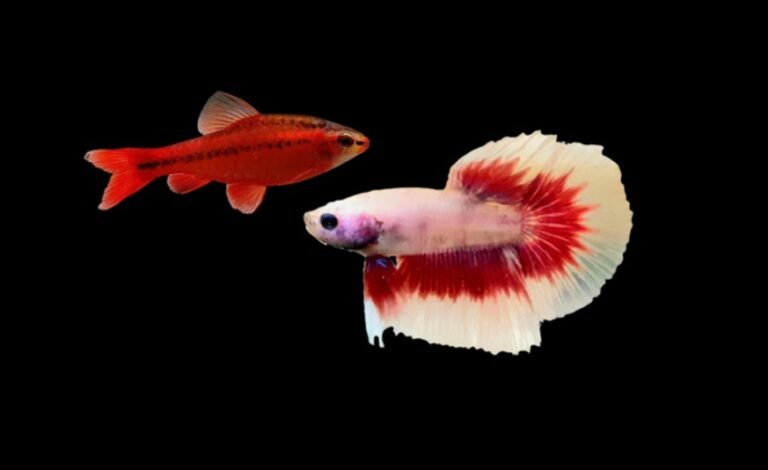5 Signs And Symptoms Of Pregnant Female Betta
When your female betta fish gets fat, has a round belly, and is oversized, it is a sign of a Pregnant betta fish. Many aquarium hobbyists are curious about their reproduction process and how long it takes. Technically, the term “pregnant” does not apply to bettas since they are oviparous – meaning they lay eggs externally rather than giving live birth.
The male Betta builds a bubble nest, a collage of oxygen bubbles floated on the water’s surface, to help protect the eggs once they are laid. When a female betta is ready to spawn or lay eggs, her body becomes rounded or “gravid.” This egg-filled state lasts approximately 1-2 days.
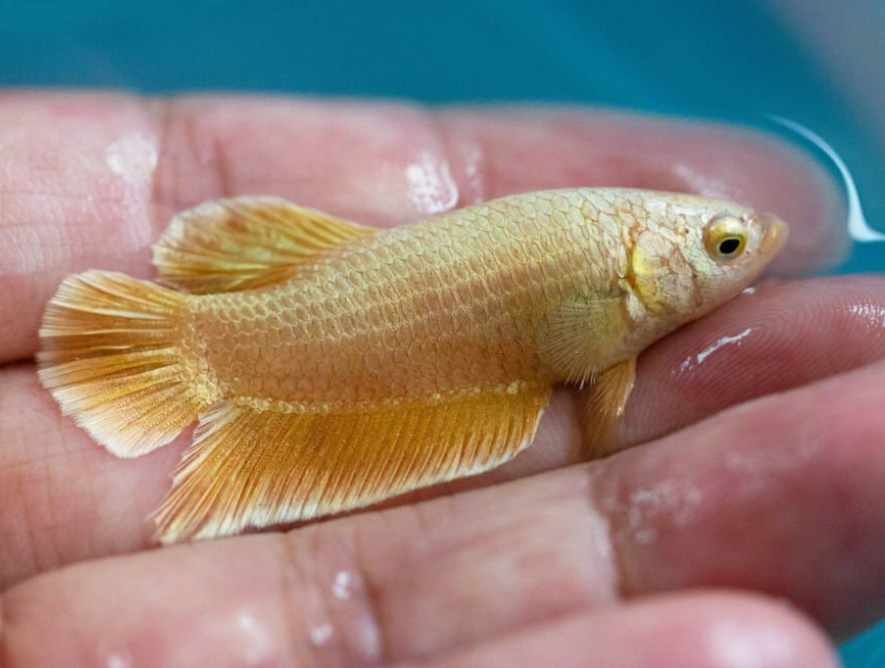
Table of Contents
- Signs and symptoms of Pregnant Betta Fish
- Mating and Egg Fertilization Process of Betta Fish
- Can Betta Female Lay Eggs Without A Male Betta?
- Conclusion
Signs and symptoms of Pregnant Betta Fish
Here are some clear signs to look for to determine if your female betta fish is getting ready to breed.
- Appearance of 5-6 Vertical Stripes:
Lighter-colored vertical bars will become visible on her body, signaling eggs are maturing.
- Rounded Belly:
Female fish belly will take on a very round, full shape as eggs develop. Don’t confuse this with bloating or overfeeding.
- White Ovipositor:
A small white dot called an ovipositor will form between her ventral and anal fins. This is where eggs will be released from.
- Interest in Bubble Nest:
If a male betta is present, a pregnant female will take great interest in any bubble nest he constructs, signaling she is ready to spawn.
- Darkened Body Color:
Her normal body coloration will become darker/more intensified as hormones shift before breeding.
Keep an eye out for these giveaways! Once you spot a few, you’ll know your female Betta is ripe with eggs and ready to become a mother. Providing perfect water conditions can help encourage a successful, healthy spawn.
Mating and Egg Fertilization Process of Betta Fish
Betta fish undergo an elaborate mating ritual before the female releases her eggs to be fertilized. It all starts when a healthy, mature betta pair between 4-12 months old is introduced in optimal tank conditions.
Start female Betta to produce eggs, and arrange a proper tank for female and male betta fish. Use always stocked/ aged water. Add 1/2 teaspoon of rock salt into the tank. Add one Indian almond leaf to keep pH and ammonia under control. Always feed live fish food like Moina or daphnia to your bettas.
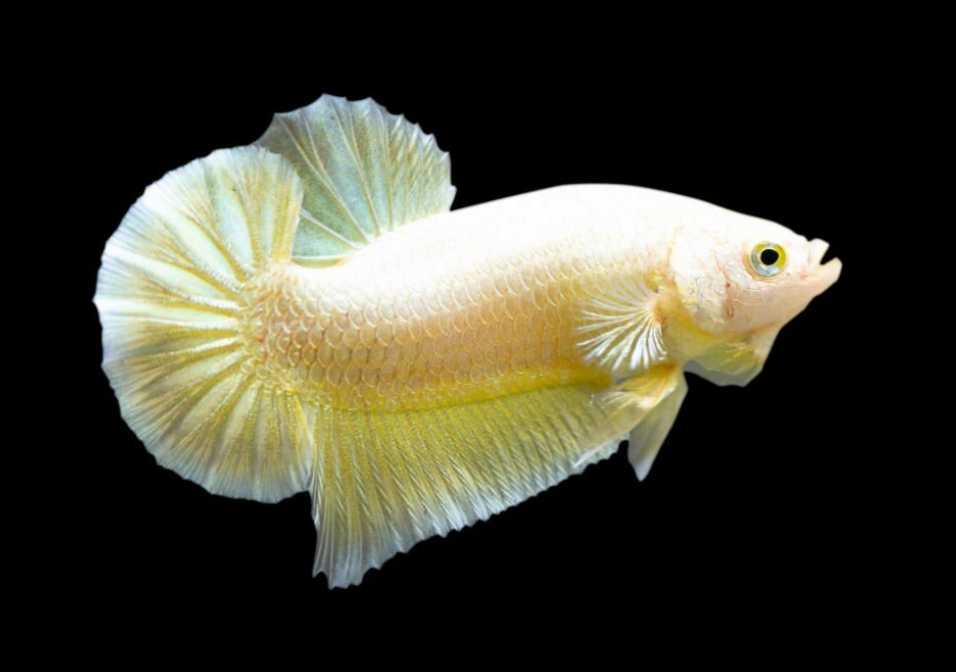
The female’s body darkens, and vertical stripes appear when she’s ready to mate, usually during breeding season. If interested, the male Betta begins building a bubble nest – a delicate structure of saliva-coated bubbles on the water’s surface. Construction of this nest can take 1-2 days as the male works tirelessly, blowing bubbles up to 2 inches wide.
The female inspects the nest to ensure the male is satisfactory and devoted to rearing offspring. If not up to her standards, she destroys the nest. But once approved, the mating dance intensifies! The two fish swim side-by-side, circling each other as if choreographed. When ready, the male wraps himself around the female, squeezing her eggs down the ovipositor.
He gathers each egg, deposits them safely in the bubble nest, and fertilizes them once all 20-150 eggs are nested. The male aggressively guards these eggs for 72-120 hours until they hatch into tiny fry and can swim unassisted. Throughout incubation, he attentively returns stray eggs or fry that fall out back to the nest.
Indeed, it is an intricate process! The male Betta’s diligent bubble nest building and protective parenting ensures success for the next generation of these spectacular fish.
So, while bettas do not experience pregnancy, the fascinating process from gravid female to free-swimming fry takes approximately 3-5 days. With proper care, these tiny betta fries can grow into full-sized, brilliantly-colored fish ready to continue the reproduction cycle.
Here are some additional facts to follow.
- Use a Spacious Tank – A 10+ gallon tank with plenty of hiding spots reduces stress and aggression during pairing.
- Optimize Water Conditions – Keep water pristine with a pH of around 7.0, soft water, and temperatures between 78-82°F.
- Introduce a Quality Male – Pick a male with vibrant colors/fins who readily build bubble nests.
- Feed Live Foods – Daphnia, brine shrimp, and other protein-rich live foods will boost fertility.
- Watch for Courtship Signs – Vertical bars, ovipositor, and bubble nest interest signal is the readiness to breed.
- Remove Parents After Spawning – The male cares for eggs; parents may fight if left together.
With the right environment, nutrition, and compatible fish, you can help your female Betta successfully produce a spawn of hundreds of eggs to continue the breeding cycle!
How Many Eggs Do Bettas Lay?
The number of eggs a female betta fish can produce varies widely based on age and size. Here are some more details.
- Egg Count Range: A typical spawning will result in 50-100 eggs but could be as low as 50 or as high as 100+ eggs.
- Influencing Factors: Older, larger females tend to produce more eggs, sometimes up to 500. Good conditioning and genetics also increase egg count.
- Fertilization Rate: Of those spawned, the male usually fertilizes around 90% of the eggs as long as conditions are right.
- Unfertilized Eggs: Any eggs not fertilized will be consumed by the parents as a protein source.
- Multiple Spawns: Mature females can spawn every 2-3 weeks, producing hundreds of offspring yearly.
- Egg Viability: Proper parental care improves egg hatching rates and fry survival.
So, a single betta fish breeding session can yield anywhere from a few dozen to several hundred eggs or more, depending on the female’s traits and health.
What Do Betta Fish Eggs Look Like?
Betta fish eggs are not transparent and separate from one another. It is tiny and hard to see at first glance. Betta eggs are tiny cream-colored spheres, initially easy to mistake for bubbles or debris. But upon close inspection in the bubble nest, the pearl-like cluster of eggs is visible right after spawning occurs.
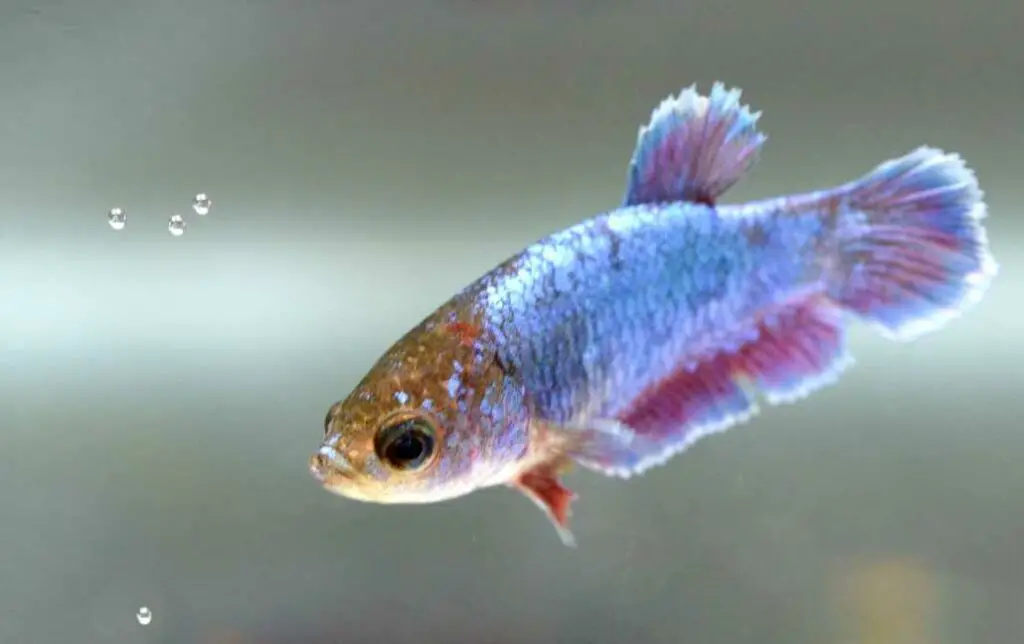
Here are some more details on identifying betta fish eggs.
- Size – Approximately 1-1.5mm in diameter, similar to a grain of table salt.
- Shape – Spherical and slightly oval. Some describe the shape as resembling a water droplet.
- Color – Opaque white, cream, or light yellow. It’s more transparent than a bubble nest.
- Surface – Smooth, with a fine chorion layer covering the fluid inside.
- Grouped – Eggs are laid in a cluster, then scattered into a nest by the male.
- Location – After spawning, eggs are nested in a bubble nest at the water’s surface.
- Development – Embryo forms within 24 hours, seen as a small dark spot.
How To Tell If Betta Eggs Are Fertilized?
Here are some clear signs of whether betta eggs have successfully fertilized.
- Black/Gray Dot – Fertilized eggs will have a dark, enlarged embryo spot. Unfertilized eggs lack an embryo.
- Developing Shape – The embryo outline becomes more defined, with a tail segment visible.
- Hatching – Fertilized eggs will hatch into free-swimming fry in 2-3 days—unfertilized eggs fungus or decay.
- Male Attention – A diligent father will tend to and guard only viable fertilized eggs in his bubble nest.
- Female Interest – She will usually eat unfertilized eggs immediately but leave fertilized ones for the male.
So, look for the presence and steady growth of an internal dark dot, continued male care, defined embryo, and eventual hatching to confirm your betta eggs have been fertilized and are developing normally.
Betta Fish Eggs To Hatching
Once betta fish eggs are fertilized and safely nestled in the male’s bubble nest, they take approximately 2-3 days to develop and hatch into fry fully. Here’s a more detailed breakdown.
- Egg Release – The female Betta releases her eggs during an elaborate spawning embrace dance with the male. He fertilizes them externally.
- Bubble Nest – The male gathers the fertilized eggs in his mouth and deposits them into the bubble nest he constructed beforehand.
- Early Development – Cell division rapidly occurs over the next 24 hours as the embryos develop inside the eggs.
- Hatching – At the 48-hour mark, the fry begins to hatch from their eggs. This hatching process can take 12-24 hours to complete fully.
- Absorption – In the 12-24 hours after hatching, the fry continues to absorb their yolk sacs for nourishment.
- Free Swimming – Approximately 72-96 hours after spawning, the tiny betta fry are free swimming and ready to venture out of the protection of the bubble nest!
So, it’s about a 3-day incubation process from egg release to free swimming fry. Proper nesting by the father ensures higher hatch rates during this vulnerable developmental period.
Can Betta Female Lay Eggs Without A Male Betta?
Female betta fish can still lay unfertilized eggs even without a male present to mate with. Here is some additional detail.
- Egg Development: It is natural for a female betta to develop a cluster of eggs periodically in her ovary, whether a male is present or not. These immature eggs will grow until they eventually need to be released.
- Ovipositing: If no male is available for breeding, the female will still go through releasing or “ovipositing” her eggs. She may even display spawning behaviors like hiding or seeking a bubble nest.
- Infertile Eggs: Since the male never fertilized the eggs, they will simply sink to the bottom of the tank and decompose. The female may eat some of the eggs as well.
- Frequency: Egg laying and releasing can occur multiple times over a female betta’s lifespan. It is part of their natural reproductive cycle.
So, female bettas can lay eggs even without a male present to fertilize them. As long as the female remains healthy, this is normal and not a cause for concern! Monitoring water quality and providing a well-balanced diet is advisable.
www.tinyfishtank.com
Conclusion
- Use Proper Terminology – Bettas are oviparous, not viviparous, so “gravid,” not “pregnant,” is accurate regarding egg development.
- Look for Spawning Signs – Watch for female color changes, ovipositor development, and bubble nest interest to identify gravidity.
- Control the Introduction – Carefully introduce a compatible male when the female shows breeding signs, then separate after spawning.
- Let the Male Parent – Allow the male Betta to diligently tend and fertilize the eggs, then guard the hatchlings until free-swimming.
- Enjoy the Reward – If successful, you’ll get the satisfaction of watching a batch of tiny betta fry grow into juvenile fish and beyond!
Breeding bettas takes some research, preparation, and close observation. But the chance to continue propagating these spectacular fish is an opportunity many aquarists find incredibly rewarding. Use these tips to set your pair up for success!
